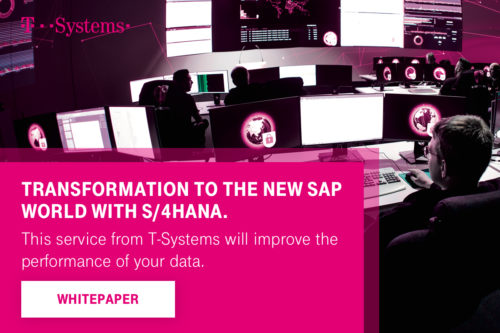SAP S/4HANA: Improving performance and historizing legacy data
The migration to SAP S/4HANA is a demanding task. In this article, IT and SAP managers can discover the right technical approach to a historization project. With M.A.R.S., T-Systems is offering a unique managed service for the secure migration of your SAP legacy data. Read more in this article.
The software from SAP is powerful, and SAP S/4HANA represents a quantum leap in terms of speed and analysis techniques. The road to the new version, however, can often be difficult. As an IT manager, you know that every migration is a challenge – heterogeneous IT environments, different release statuses and world-wide distributed systems and applications – especially when you are talking about the ERP software, the beating heart of a company. SAP represents powerful, high-performance software, but also sometimes involves time-consuming implementation and complexity.
By 2025 at the latest, the migration of old SAP versions to SAP S/4HANA will be unavoidable. At this point SAP will end support for the predecessors.
The move to SAP/4HANA brings companies more advantages than any comparable update ever, and facilitates new business models, more efficient processes, cost-efficiency and greater productivity.
According to a study by PAC market researchers, two thirds of German companies expect that a migration to SAP S/4HANA will accelerate processes and data analyses, while more than half expect it to deliver the modernization of applications and infrastructure. According to the PAC, however, decision-makers also fear that too many modifications can make the introduction of SAP S/4HANA overly complex.
Historizing legacy data
A particular problem with the migration to SAP S/4HANA is how to deal with legacy data. All large companies have a long history and are faced with the question as to what happens to legacy data when they opt for the new version of SAP S/4HANA. Because SAP S/4HANA has so many changes compared with its predecessors, a simple 1 to 1 takeover is simply not possible. Data migration is, in fact, the biggest problem on the way to SAP S/4HANA, in terms of the risk, time and cost involved. Heterogeneous SAP landscapes can be very complex, often with many company-specific peculiarities to be taken into account.
The highly experienced T-Systems Managed Application Retirement Services (M.A.R.S.) team apply a unique methodology for the historization of legacy data, making it possible to clear up and modernize expensive and risk-laden system landscapes. A standardised project approach with global back-up services and a highly secure cloud operating system delivers major cost saving and long-term data availability.
For the historization, the legacy data is removed and the old system decommissioned. This is more than a migration. With the M.A.R.S. service, 100% of relevant data is taken to a new platform and historized in accordance with local legal requirements.
Using Managed Application Retirement Services, data and documents are transferred to a high-security, dedicated, cloud environment, fully taking into consideration individual company requirements. In the new environment, all compliance requirements can be easily implemented – automatically fulfilling legal regulations such as GDPR and GoBD.
In a lot of cases, the migration to SAP S/4HANA means that many old applications reach the end of their life cycle and become surplus to requirements. Historization ensures that the data in these old applications is collected and transferred to a new, future-proof platform that is independent of the source system technology.
Don’t forget the data quantity and quality
The focus of the S/4HANA roadmap often lies on functionality or the use of new options withinS/4HANA. Data quantity and quality can be easily overlooked yet they play a central role in the successful introduction of S/4HANA.
It is also usually forgotten that, after the introduction of S/4HANA, many of the old SAP systems remain in operation. It is essential, therefore, that a historisation roadmap is developed at an early stage of planning for an S/4HANA migration to reduce technical debt and release funds for future investment.
Preparing historical data
Before the migration to SAP S/4HANA, historical data first has to be prepared. Data that is no longer required has to be extracted and duplicates cleared. The historical data then has to be standardized and enriched with information relevant to SAP S/4HANA.
For this purpose, existing SAP customers can use the standard tool, Solution Manager 7.2, which offers only limited options for data administration and data quality. The SAP Migration Cockpit perhaps is a better way of ensuring the consistent importing of data.

Clear and Cecommission
SAP systems often have components that are no longer active such as ABAP functions from the Z-namespace as well as settings in the FI/CO area.
No-longer required company codes are an unnecessary burden on a SAP system and should be removed. For legal reasons, the deletion of company codes is subject to certain considerations. With the historization solution, however, secure deletion in SAP is easily possible.
Proof of Concept
The historization of the legacy data project in a Proof of Concept takes around three months. The data from an old system is historized, either on-premise or in the Open Telekom Cloud. All the relevant data is transferred and reports compiled. Technical tests ensure that everything has been accomplished successfully. This is followed by the assessment of the results and the user training.
The auditable historization of the legacy data means that you can completely shut down your old systems after the migration. The shutdown is normally delivers cost savings of between 60-80% when compared to allowing the old systems to continue running.
Using T-Systems Managed Application Retirement Services is a low cost means of historisation, resulting in a rapid return on investment and the removal of all the problems associated with a non-productive legacy estate. Moreover, all of the data is then made centrally available and easily accessible on a single M.A.R.S. platform.
Source picture: iStock / PeopleImages
[plista]




